Collecting Data for PAWS Fundraising Activity
VerifiedAdded on 2023/06/10
|7
|2230
|176
AI Summary
Thandi Majoro, the Executive Director at PAWS (People Against Waste Streams), has some concerns about the upcoming PAWS Annual General Meeting: she is worried about how she is going to present her concerns with fundraising activity over the last financial year. PAWS was established five years ago in response to Thandi’s observation that many large industrial companies were ignoring their toxic or potentially toxic waste streams. She also noted that this would have a long-term negative effect on the environment if left unchecked, as well as on the health of individuals living close to dump sites and processing plants. Learn how to collect qualitative and quantitative data for PAWS fundraising activity. Understand the tools and instruments to be used for collecting data.
Contribute Materials
Your contribution can guide someone’s learning journey. Share your
documents today.
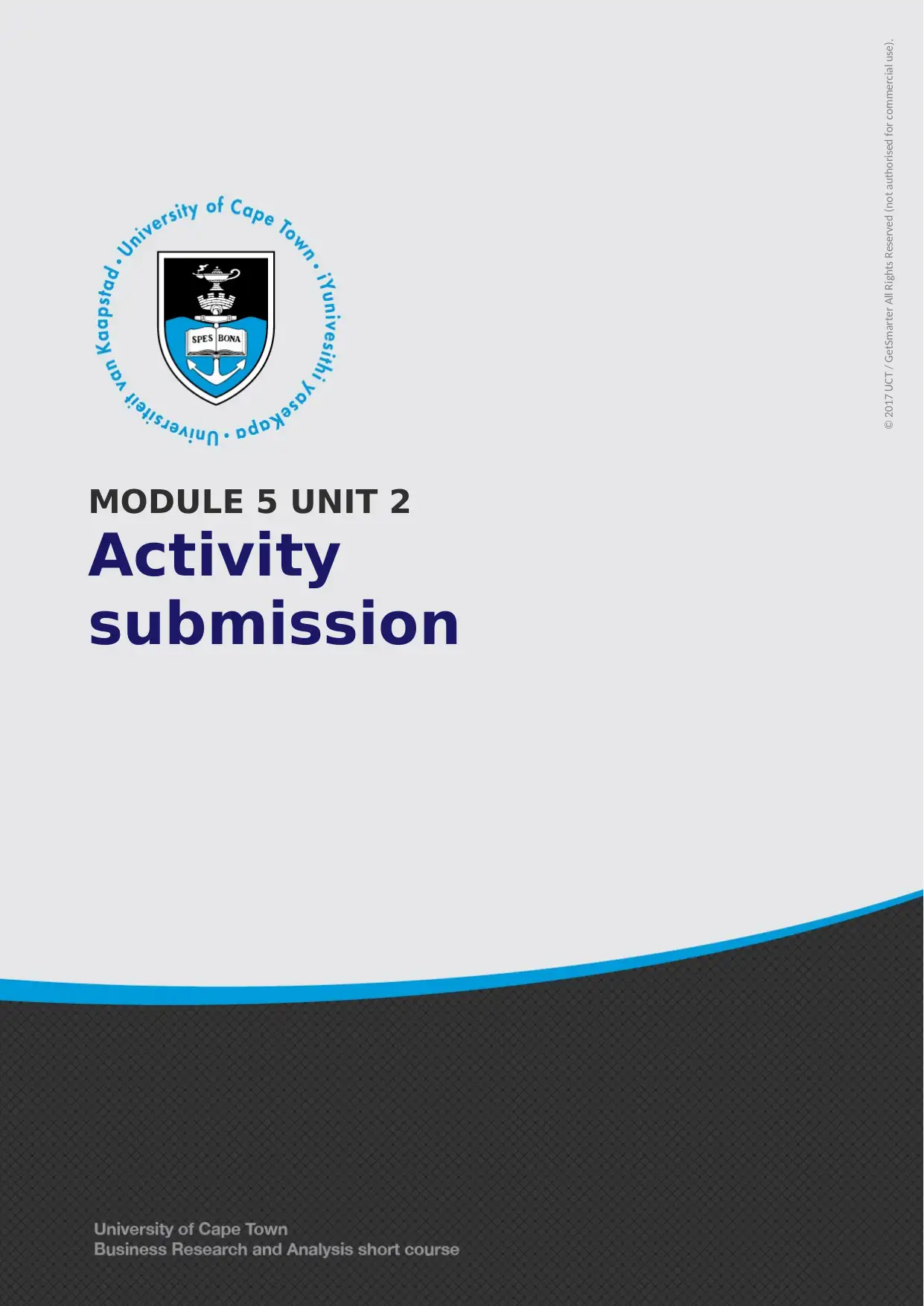
MODULE 5 UNIT 2
Activity
submission
© 2017 UCT / GetSmarter All Rights Reserved (not authorised for commercial use).
Activity
submission
© 2017 UCT / GetSmarter All Rights Reserved (not authorised for commercial use).
Secure Best Marks with AI Grader
Need help grading? Try our AI Grader for instant feedback on your assignments.
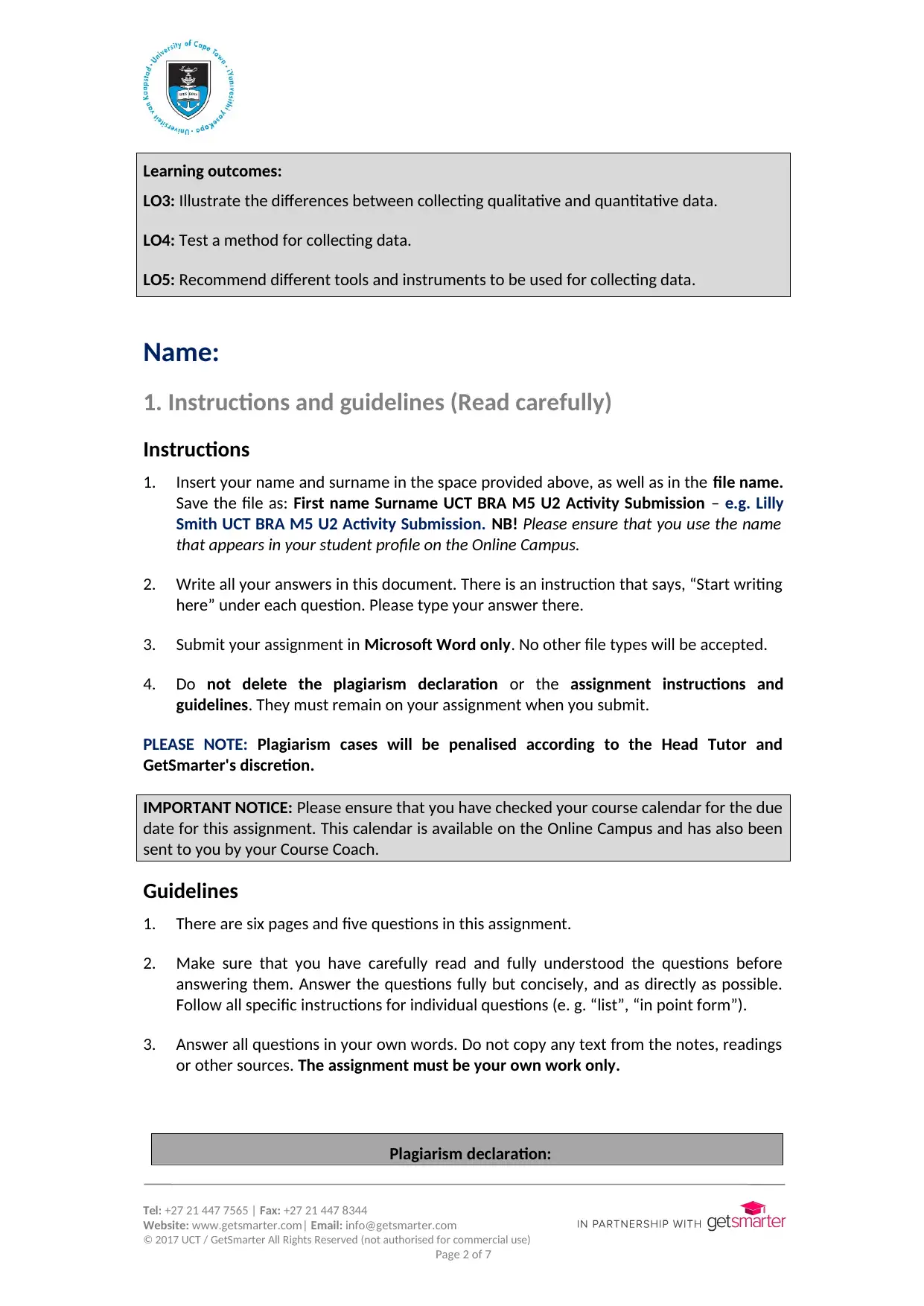
Learning outcomes:
LO3: Illustrate the differences between collecting qualitative and quantitative data.
LO4: Test a method for collecting data.
LO5: Recommend different tools and instruments to be used for collecting data.
Name:
1. Instructions and guidelines (Read carefully)
Instructions
1. Insert your name and surname in the space provided above, as well as in the file name.
Save the file as: First name Surname UCT BRA M5 U2 Activity Submission – e.g. Lilly
Smith UCT BRA M5 U2 Activity Submission. NB! Please ensure that you use the name
that appears in your student profile on the Online Campus.
2. Write all your answers in this document. There is an instruction that says, “Start writing
here” under each question. Please type your answer there.
3. Submit your assignment in Microsoft Word only. No other file types will be accepted.
4. Do not delete the plagiarism declaration or the assignment instructions and
guidelines. They must remain on your assignment when you submit.
PLEASE NOTE: Plagiarism cases will be penalised according to the Head Tutor and
GetSmarter's discretion.
IMPORTANT NOTICE: Please ensure that you have checked your course calendar for the due
date for this assignment. This calendar is available on the Online Campus and has also been
sent to you by your Course Coach.
Guidelines
1. There are six pages and five questions in this assignment.
2. Make sure that you have carefully read and fully understood the questions before
answering them. Answer the questions fully but concisely, and as directly as possible.
Follow all specific instructions for individual questions (e. g. “list”, “in point form”).
3. Answer all questions in your own words. Do not copy any text from the notes, readings
or other sources. The assignment must be your own work only.
Plagiarism declaration:
Tel: +27 21 447 7565 | Fax: +27 21 447 8344
Website: www.getsmarter.com| Email: info@getsmarter.com
© 2017 UCT / GetSmarter All Rights Reserved (not authorised for commercial use)
Page 2 of 7
LO3: Illustrate the differences between collecting qualitative and quantitative data.
LO4: Test a method for collecting data.
LO5: Recommend different tools and instruments to be used for collecting data.
Name:
1. Instructions and guidelines (Read carefully)
Instructions
1. Insert your name and surname in the space provided above, as well as in the file name.
Save the file as: First name Surname UCT BRA M5 U2 Activity Submission – e.g. Lilly
Smith UCT BRA M5 U2 Activity Submission. NB! Please ensure that you use the name
that appears in your student profile on the Online Campus.
2. Write all your answers in this document. There is an instruction that says, “Start writing
here” under each question. Please type your answer there.
3. Submit your assignment in Microsoft Word only. No other file types will be accepted.
4. Do not delete the plagiarism declaration or the assignment instructions and
guidelines. They must remain on your assignment when you submit.
PLEASE NOTE: Plagiarism cases will be penalised according to the Head Tutor and
GetSmarter's discretion.
IMPORTANT NOTICE: Please ensure that you have checked your course calendar for the due
date for this assignment. This calendar is available on the Online Campus and has also been
sent to you by your Course Coach.
Guidelines
1. There are six pages and five questions in this assignment.
2. Make sure that you have carefully read and fully understood the questions before
answering them. Answer the questions fully but concisely, and as directly as possible.
Follow all specific instructions for individual questions (e. g. “list”, “in point form”).
3. Answer all questions in your own words. Do not copy any text from the notes, readings
or other sources. The assignment must be your own work only.
Plagiarism declaration:
Tel: +27 21 447 7565 | Fax: +27 21 447 8344
Website: www.getsmarter.com| Email: info@getsmarter.com
© 2017 UCT / GetSmarter All Rights Reserved (not authorised for commercial use)
Page 2 of 7

1. I know that plagiarism is wrong. Plagiarism is to use another’s work and pretend
that it is one’s own.
2. This assignment is my own work.
3. I have not allowed, and will not allow, anyone to copy my work with the intention
of passing it off as his or her own work.
4. I acknowledge that copying someone else’s assignment (or part of it) is wrong, and
declare that my assignments are my own work.
2. Mark allocation
Each question receives a mark allocation. However, you will only receive a final percentage
mark and will not be given individual marks for each question. The mark allocation is there
to show you the weighting and length of each question.
Question 1 4
Question 2 5
Question 3 5
Question 4 6
Question 5 15
TOTAL 35
3. Assignment questions
The questions in this activity submission are based on the following case study.
PAWS (People Against Waste Streams):
Thandi Majoro, the Executive Director at PAWS (People Against Waste Streams), has some
concerns about the upcoming PAWS Annual General Meeting: she is worried about how she
is going to present her concerns with fundraising activity over the last financial year. PAWS
was established five years ago in response to Thandi’s observation that many large
industrial companies were ignoring their toxic or potentially toxic waste streams. She also
noted that this would have a long-term negative effect on the environment if left
unchecked, as well as on the health of individuals living close to dump sites and processing
plants. Thandi is an engineer and industrial designer: she knows the industry well and feels
that now is the right time for her to tackle this issue head-on. PAWS is funded entirely
through grants and donations from a combination of sources.
Tel: +27 21 447 7565 | Fax: +27 21 447 8344
Website: www.getsmarter.com| Email: info@getsmarter.com
© 2017 UCT / GetSmarter All Rights Reserved (not authorised for commercial use)
Page 3 of 7
that it is one’s own.
2. This assignment is my own work.
3. I have not allowed, and will not allow, anyone to copy my work with the intention
of passing it off as his or her own work.
4. I acknowledge that copying someone else’s assignment (or part of it) is wrong, and
declare that my assignments are my own work.
2. Mark allocation
Each question receives a mark allocation. However, you will only receive a final percentage
mark and will not be given individual marks for each question. The mark allocation is there
to show you the weighting and length of each question.
Question 1 4
Question 2 5
Question 3 5
Question 4 6
Question 5 15
TOTAL 35
3. Assignment questions
The questions in this activity submission are based on the following case study.
PAWS (People Against Waste Streams):
Thandi Majoro, the Executive Director at PAWS (People Against Waste Streams), has some
concerns about the upcoming PAWS Annual General Meeting: she is worried about how she
is going to present her concerns with fundraising activity over the last financial year. PAWS
was established five years ago in response to Thandi’s observation that many large
industrial companies were ignoring their toxic or potentially toxic waste streams. She also
noted that this would have a long-term negative effect on the environment if left
unchecked, as well as on the health of individuals living close to dump sites and processing
plants. Thandi is an engineer and industrial designer: she knows the industry well and feels
that now is the right time for her to tackle this issue head-on. PAWS is funded entirely
through grants and donations from a combination of sources.
Tel: +27 21 447 7565 | Fax: +27 21 447 8344
Website: www.getsmarter.com| Email: info@getsmarter.com
© 2017 UCT / GetSmarter All Rights Reserved (not authorised for commercial use)
Page 3 of 7
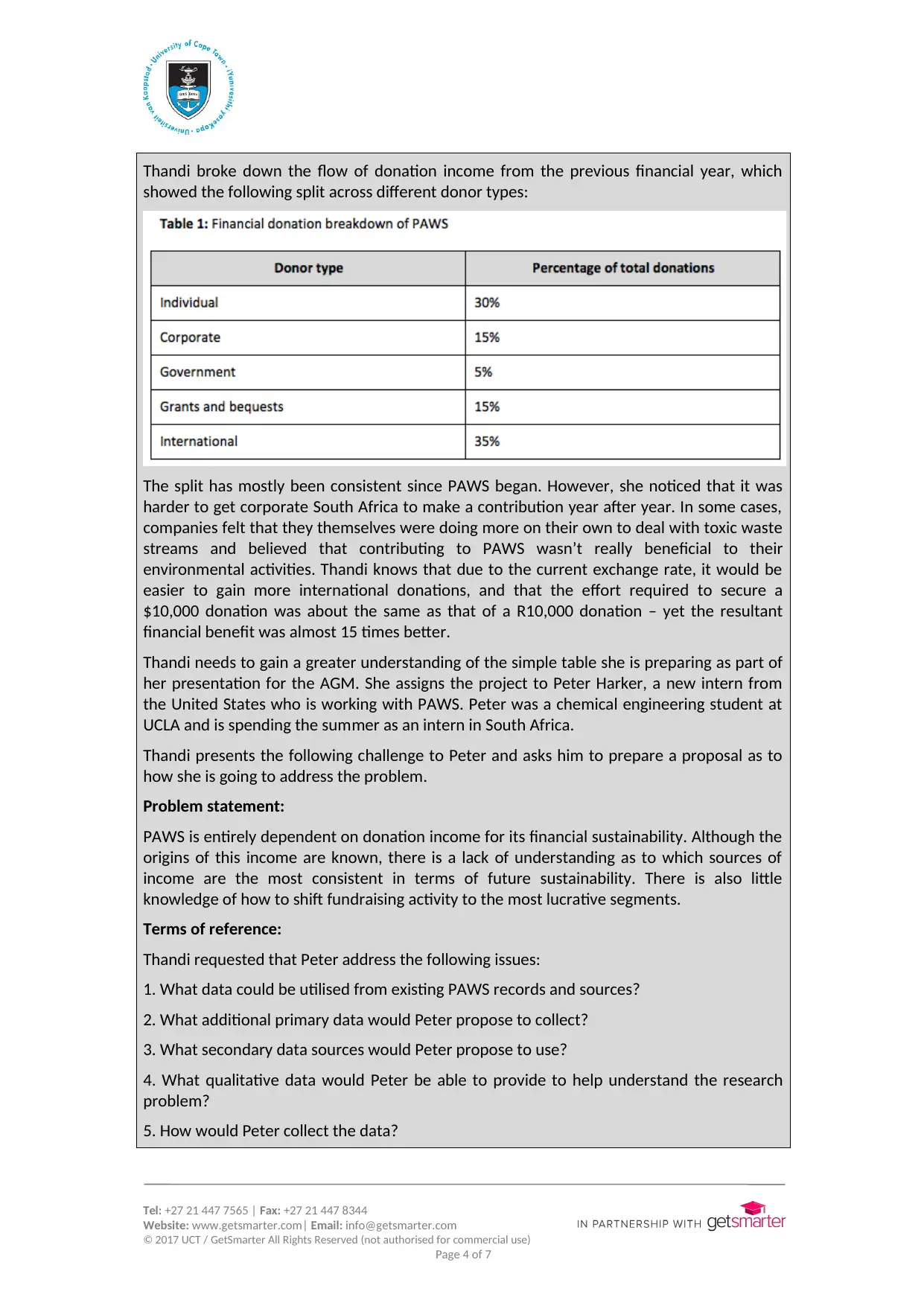
Thandi broke down the flow of donation income from the previous financial year, which
showed the following split across different donor types:
The split has mostly been consistent since PAWS began. However, she noticed that it was
harder to get corporate South Africa to make a contribution year after year. In some cases,
companies felt that they themselves were doing more on their own to deal with toxic waste
streams and believed that contributing to PAWS wasn’t really beneficial to their
environmental activities. Thandi knows that due to the current exchange rate, it would be
easier to gain more international donations, and that the effort required to secure a
$10,000 donation was about the same as that of a R10,000 donation – yet the resultant
financial benefit was almost 15 times better.
Thandi needs to gain a greater understanding of the simple table she is preparing as part of
her presentation for the AGM. She assigns the project to Peter Harker, a new intern from
the United States who is working with PAWS. Peter was a chemical engineering student at
UCLA and is spending the summer as an intern in South Africa.
Thandi presents the following challenge to Peter and asks him to prepare a proposal as to
how she is going to address the problem.
Problem statement:
PAWS is entirely dependent on donation income for its financial sustainability. Although the
origins of this income are known, there is a lack of understanding as to which sources of
income are the most consistent in terms of future sustainability. There is also little
knowledge of how to shift fundraising activity to the most lucrative segments.
Terms of reference:
Thandi requested that Peter address the following issues:
1. What data could be utilised from existing PAWS records and sources?
2. What additional primary data would Peter propose to collect?
3. What secondary data sources would Peter propose to use?
4. What qualitative data would Peter be able to provide to help understand the research
problem?
5. How would Peter collect the data?
Tel: +27 21 447 7565 | Fax: +27 21 447 8344
Website: www.getsmarter.com| Email: info@getsmarter.com
© 2017 UCT / GetSmarter All Rights Reserved (not authorised for commercial use)
Page 4 of 7
showed the following split across different donor types:
The split has mostly been consistent since PAWS began. However, she noticed that it was
harder to get corporate South Africa to make a contribution year after year. In some cases,
companies felt that they themselves were doing more on their own to deal with toxic waste
streams and believed that contributing to PAWS wasn’t really beneficial to their
environmental activities. Thandi knows that due to the current exchange rate, it would be
easier to gain more international donations, and that the effort required to secure a
$10,000 donation was about the same as that of a R10,000 donation – yet the resultant
financial benefit was almost 15 times better.
Thandi needs to gain a greater understanding of the simple table she is preparing as part of
her presentation for the AGM. She assigns the project to Peter Harker, a new intern from
the United States who is working with PAWS. Peter was a chemical engineering student at
UCLA and is spending the summer as an intern in South Africa.
Thandi presents the following challenge to Peter and asks him to prepare a proposal as to
how she is going to address the problem.
Problem statement:
PAWS is entirely dependent on donation income for its financial sustainability. Although the
origins of this income are known, there is a lack of understanding as to which sources of
income are the most consistent in terms of future sustainability. There is also little
knowledge of how to shift fundraising activity to the most lucrative segments.
Terms of reference:
Thandi requested that Peter address the following issues:
1. What data could be utilised from existing PAWS records and sources?
2. What additional primary data would Peter propose to collect?
3. What secondary data sources would Peter propose to use?
4. What qualitative data would Peter be able to provide to help understand the research
problem?
5. How would Peter collect the data?
Tel: +27 21 447 7565 | Fax: +27 21 447 8344
Website: www.getsmarter.com| Email: info@getsmarter.com
© 2017 UCT / GetSmarter All Rights Reserved (not authorised for commercial use)
Page 4 of 7
Secure Best Marks with AI Grader
Need help grading? Try our AI Grader for instant feedback on your assignments.
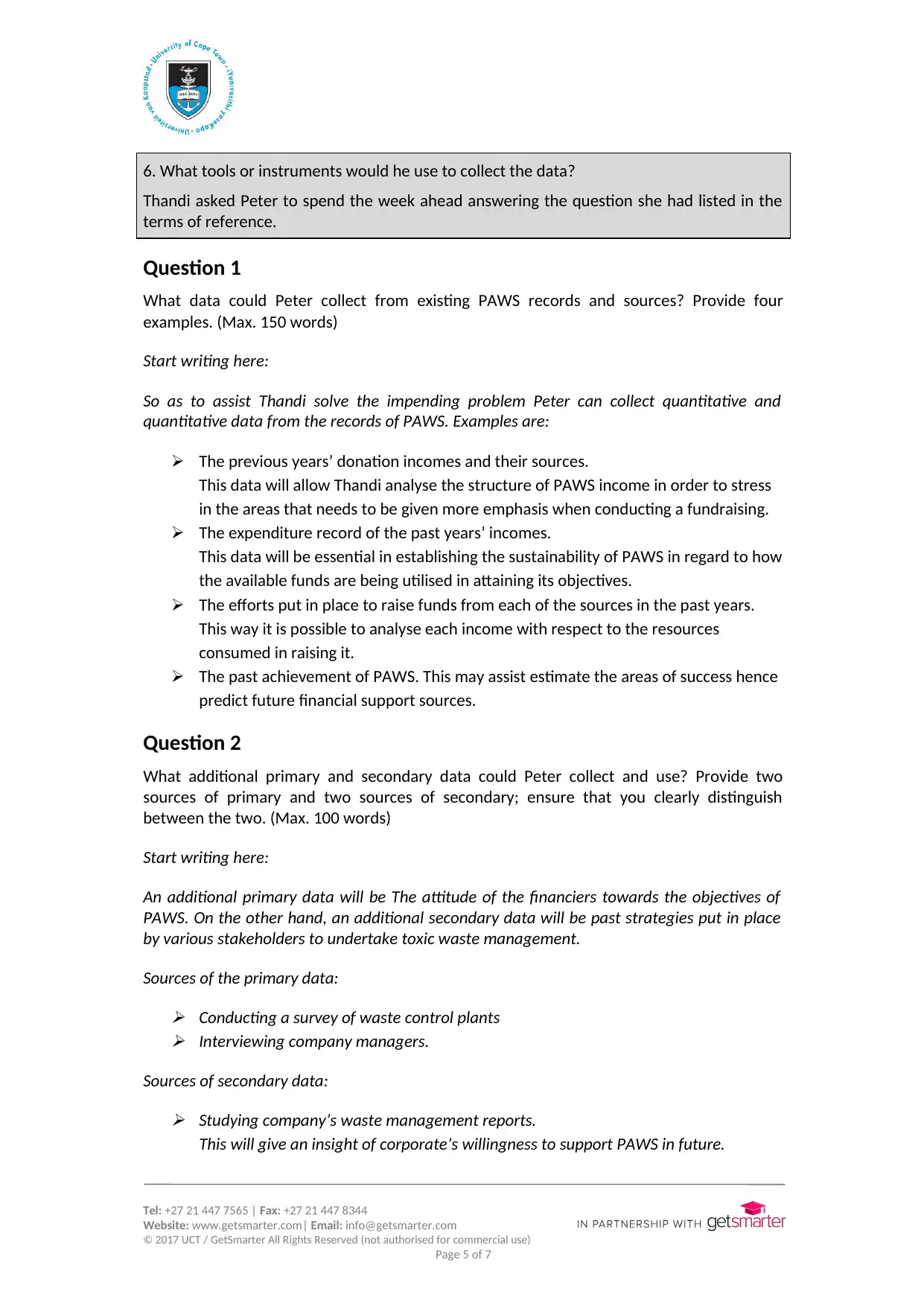
6. What tools or instruments would he use to collect the data?
Thandi asked Peter to spend the week ahead answering the question she had listed in the
terms of reference.
Question 1
What data could Peter collect from existing PAWS records and sources? Provide four
examples. (Max. 150 words)
Start writing here:
So as to assist Thandi solve the impending problem Peter can collect quantitative and
quantitative data from the records of PAWS. Examples are:
The previous years’ donation incomes and their sources.
This data will allow Thandi analyse the structure of PAWS income in order to stress
in the areas that needs to be given more emphasis when conducting a fundraising.
The expenditure record of the past years’ incomes.
This data will be essential in establishing the sustainability of PAWS in regard to how
the available funds are being utilised in attaining its objectives.
The efforts put in place to raise funds from each of the sources in the past years.
This way it is possible to analyse each income with respect to the resources
consumed in raising it.
The past achievement of PAWS. This may assist estimate the areas of success hence
predict future financial support sources.
Question 2
What additional primary and secondary data could Peter collect and use? Provide two
sources of primary and two sources of secondary; ensure that you clearly distinguish
between the two. (Max. 100 words)
Start writing here:
An additional primary data will be The attitude of the financiers towards the objectives of
PAWS. On the other hand, an additional secondary data will be past strategies put in place
by various stakeholders to undertake toxic waste management.
Sources of the primary data: Conducting a survey of waste control plants
Interviewing company managers.
Sources of secondary data: Studying company’s waste management reports.
This will give an insight of corporate’s willingness to support PAWS in future.
Tel: +27 21 447 7565 | Fax: +27 21 447 8344
Website: www.getsmarter.com| Email: info@getsmarter.com
© 2017 UCT / GetSmarter All Rights Reserved (not authorised for commercial use)
Page 5 of 7
Thandi asked Peter to spend the week ahead answering the question she had listed in the
terms of reference.
Question 1
What data could Peter collect from existing PAWS records and sources? Provide four
examples. (Max. 150 words)
Start writing here:
So as to assist Thandi solve the impending problem Peter can collect quantitative and
quantitative data from the records of PAWS. Examples are:
The previous years’ donation incomes and their sources.
This data will allow Thandi analyse the structure of PAWS income in order to stress
in the areas that needs to be given more emphasis when conducting a fundraising.
The expenditure record of the past years’ incomes.
This data will be essential in establishing the sustainability of PAWS in regard to how
the available funds are being utilised in attaining its objectives.
The efforts put in place to raise funds from each of the sources in the past years.
This way it is possible to analyse each income with respect to the resources
consumed in raising it.
The past achievement of PAWS. This may assist estimate the areas of success hence
predict future financial support sources.
Question 2
What additional primary and secondary data could Peter collect and use? Provide two
sources of primary and two sources of secondary; ensure that you clearly distinguish
between the two. (Max. 100 words)
Start writing here:
An additional primary data will be The attitude of the financiers towards the objectives of
PAWS. On the other hand, an additional secondary data will be past strategies put in place
by various stakeholders to undertake toxic waste management.
Sources of the primary data: Conducting a survey of waste control plants
Interviewing company managers.
Sources of secondary data: Studying company’s waste management reports.
This will give an insight of corporate’s willingness to support PAWS in future.
Tel: +27 21 447 7565 | Fax: +27 21 447 8344
Website: www.getsmarter.com| Email: info@getsmarter.com
© 2017 UCT / GetSmarter All Rights Reserved (not authorised for commercial use)
Page 5 of 7
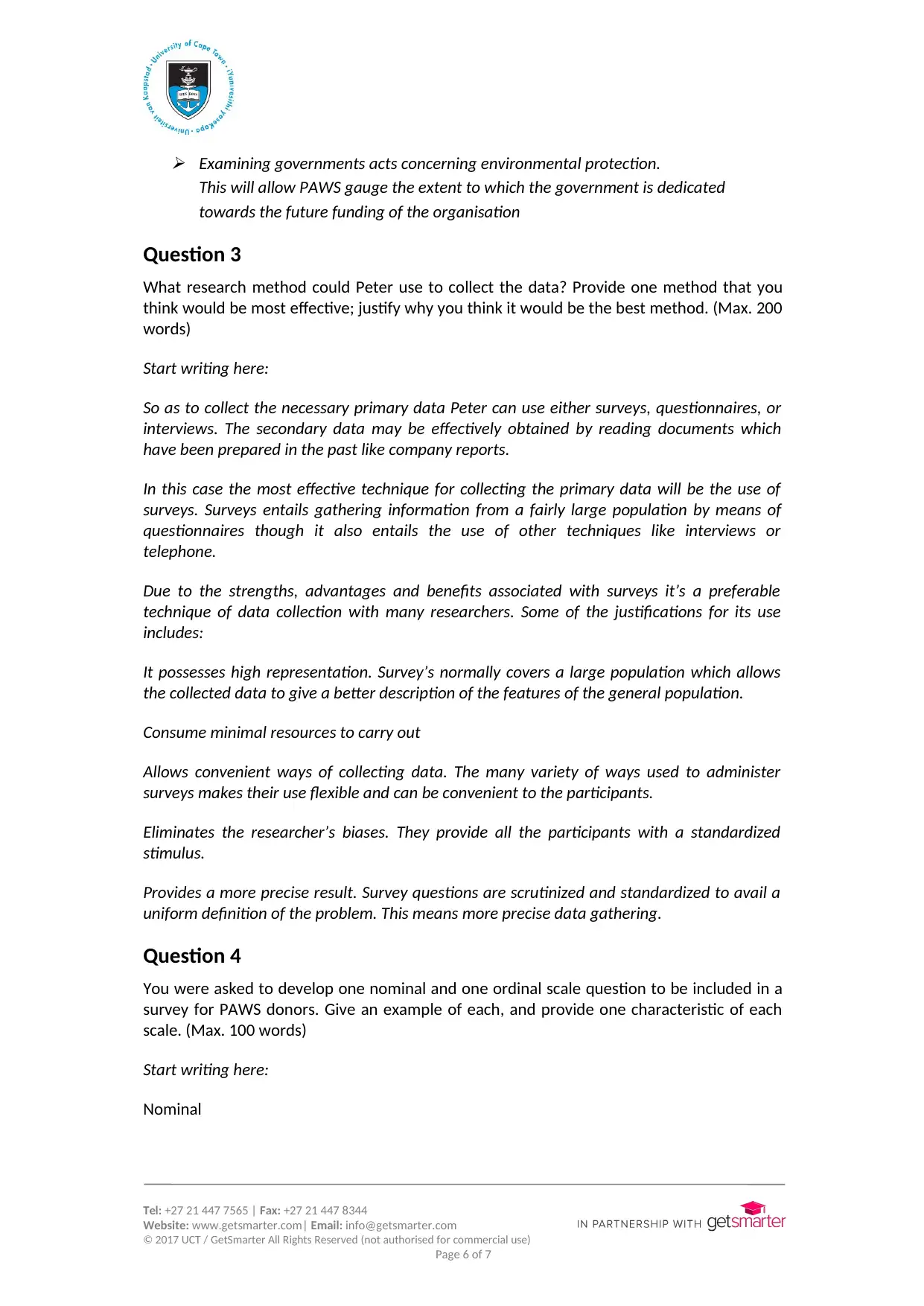
Examining governments acts concerning environmental protection.
This will allow PAWS gauge the extent to which the government is dedicated
towards the future funding of the organisation
Question 3
What research method could Peter use to collect the data? Provide one method that you
think would be most effective; justify why you think it would be the best method. (Max. 200
words)
Start writing here:
So as to collect the necessary primary data Peter can use either surveys, questionnaires, or
interviews. The secondary data may be effectively obtained by reading documents which
have been prepared in the past like company reports.
In this case the most effective technique for collecting the primary data will be the use of
surveys. Surveys entails gathering information from a fairly large population by means of
questionnaires though it also entails the use of other techniques like interviews or
telephone.
Due to the strengths, advantages and benefits associated with surveys it’s a preferable
technique of data collection with many researchers. Some of the justifications for its use
includes:
It possesses high representation. Survey’s normally covers a large population which allows
the collected data to give a better description of the features of the general population.
Consume minimal resources to carry out
Allows convenient ways of collecting data. The many variety of ways used to administer
surveys makes their use flexible and can be convenient to the participants.
Eliminates the researcher’s biases. They provide all the participants with a standardized
stimulus.
Provides a more precise result. Survey questions are scrutinized and standardized to avail a
uniform definition of the problem. This means more precise data gathering.
Question 4
You were asked to develop one nominal and one ordinal scale question to be included in a
survey for PAWS donors. Give an example of each, and provide one characteristic of each
scale. (Max. 100 words)
Start writing here:
Nominal
Tel: +27 21 447 7565 | Fax: +27 21 447 8344
Website: www.getsmarter.com| Email: info@getsmarter.com
© 2017 UCT / GetSmarter All Rights Reserved (not authorised for commercial use)
Page 6 of 7
This will allow PAWS gauge the extent to which the government is dedicated
towards the future funding of the organisation
Question 3
What research method could Peter use to collect the data? Provide one method that you
think would be most effective; justify why you think it would be the best method. (Max. 200
words)
Start writing here:
So as to collect the necessary primary data Peter can use either surveys, questionnaires, or
interviews. The secondary data may be effectively obtained by reading documents which
have been prepared in the past like company reports.
In this case the most effective technique for collecting the primary data will be the use of
surveys. Surveys entails gathering information from a fairly large population by means of
questionnaires though it also entails the use of other techniques like interviews or
telephone.
Due to the strengths, advantages and benefits associated with surveys it’s a preferable
technique of data collection with many researchers. Some of the justifications for its use
includes:
It possesses high representation. Survey’s normally covers a large population which allows
the collected data to give a better description of the features of the general population.
Consume minimal resources to carry out
Allows convenient ways of collecting data. The many variety of ways used to administer
surveys makes their use flexible and can be convenient to the participants.
Eliminates the researcher’s biases. They provide all the participants with a standardized
stimulus.
Provides a more precise result. Survey questions are scrutinized and standardized to avail a
uniform definition of the problem. This means more precise data gathering.
Question 4
You were asked to develop one nominal and one ordinal scale question to be included in a
survey for PAWS donors. Give an example of each, and provide one characteristic of each
scale. (Max. 100 words)
Start writing here:
Nominal
Tel: +27 21 447 7565 | Fax: +27 21 447 8344
Website: www.getsmarter.com| Email: info@getsmarter.com
© 2017 UCT / GetSmarter All Rights Reserved (not authorised for commercial use)
Page 6 of 7

The nominal scale only measures non-numeric quantities. In this case numbers are just used
as tags but have no value
Example
Clarify your donor type
i. Individual
ii. Corporate
iii. Government
iv. Grants/Bequests
v. International
Ordinal
Is a scale used in statistic to indicate data based on the order of magnitude as standard of
measurement difference lack.
Example
Contributions to PAWS should be made mandatory for all the South African companies
i. strongly disagree
ii. disagree
iii. neutral
iv. agree
v. strongly agree
Question 5
Peter decides to conduct a survey of all donors to PAWS. Using the online Survey Monkey
tool, draft a 10-question survey that Peter could use that will help him gather the data that
he needs to address the research problem.
Place the link to your survey in the space provided below:
Paste link here:
The link to the Survey Monkey tool containing the questions prepared is:
https://www.surveymonkey.com/r/CVZXKH5
Tel: +27 21 447 7565 | Fax: +27 21 447 8344
Website: www.getsmarter.com| Email: info@getsmarter.com
© 2017 UCT / GetSmarter All Rights Reserved (not authorised for commercial use)
Page 7 of 7
Note: Please refer to the Module Downloads folder for a guide on how to use the Survey
Monkey tool.
as tags but have no value
Example
Clarify your donor type
i. Individual
ii. Corporate
iii. Government
iv. Grants/Bequests
v. International
Ordinal
Is a scale used in statistic to indicate data based on the order of magnitude as standard of
measurement difference lack.
Example
Contributions to PAWS should be made mandatory for all the South African companies
i. strongly disagree
ii. disagree
iii. neutral
iv. agree
v. strongly agree
Question 5
Peter decides to conduct a survey of all donors to PAWS. Using the online Survey Monkey
tool, draft a 10-question survey that Peter could use that will help him gather the data that
he needs to address the research problem.
Place the link to your survey in the space provided below:
Paste link here:
The link to the Survey Monkey tool containing the questions prepared is:
https://www.surveymonkey.com/r/CVZXKH5
Tel: +27 21 447 7565 | Fax: +27 21 447 8344
Website: www.getsmarter.com| Email: info@getsmarter.com
© 2017 UCT / GetSmarter All Rights Reserved (not authorised for commercial use)
Page 7 of 7
Note: Please refer to the Module Downloads folder for a guide on how to use the Survey
Monkey tool.
1 out of 7
Related Documents
Your All-in-One AI-Powered Toolkit for Academic Success.
+13062052269
info@desklib.com
Available 24*7 on WhatsApp / Email
![[object Object]](/_next/static/media/star-bottom.7253800d.svg)
Unlock your academic potential
© 2024 | Zucol Services PVT LTD | All rights reserved.





